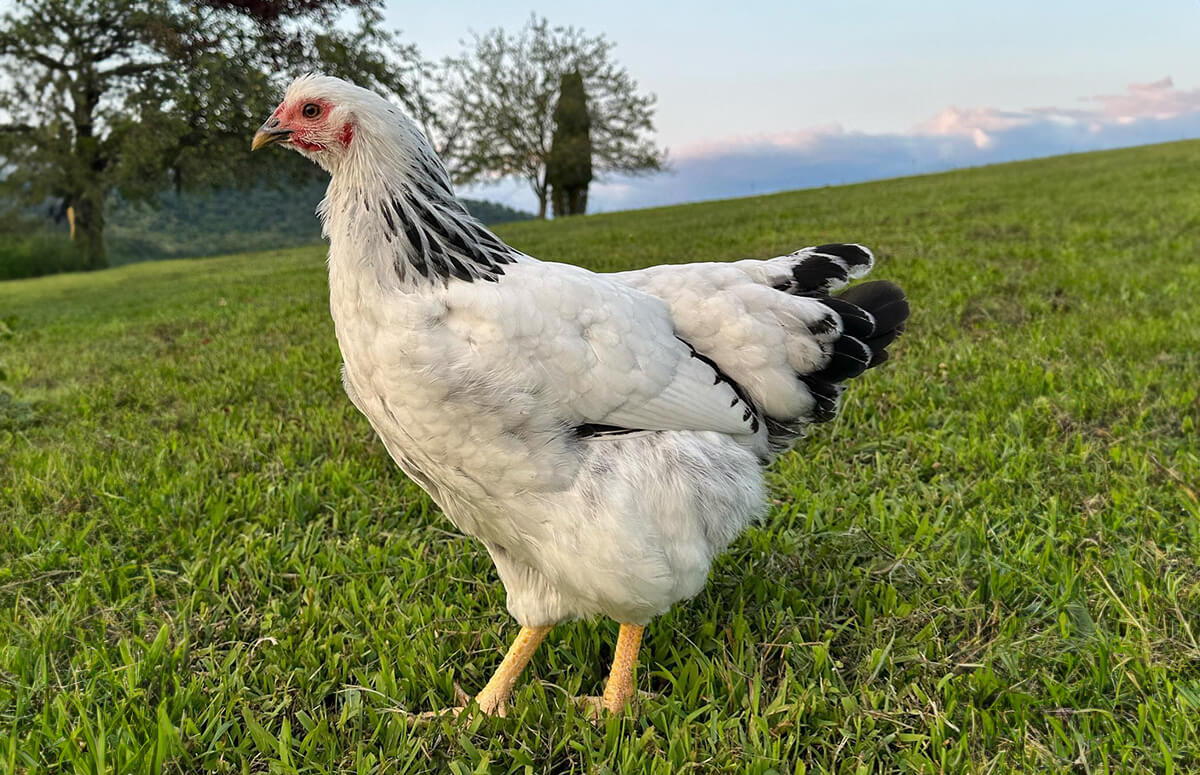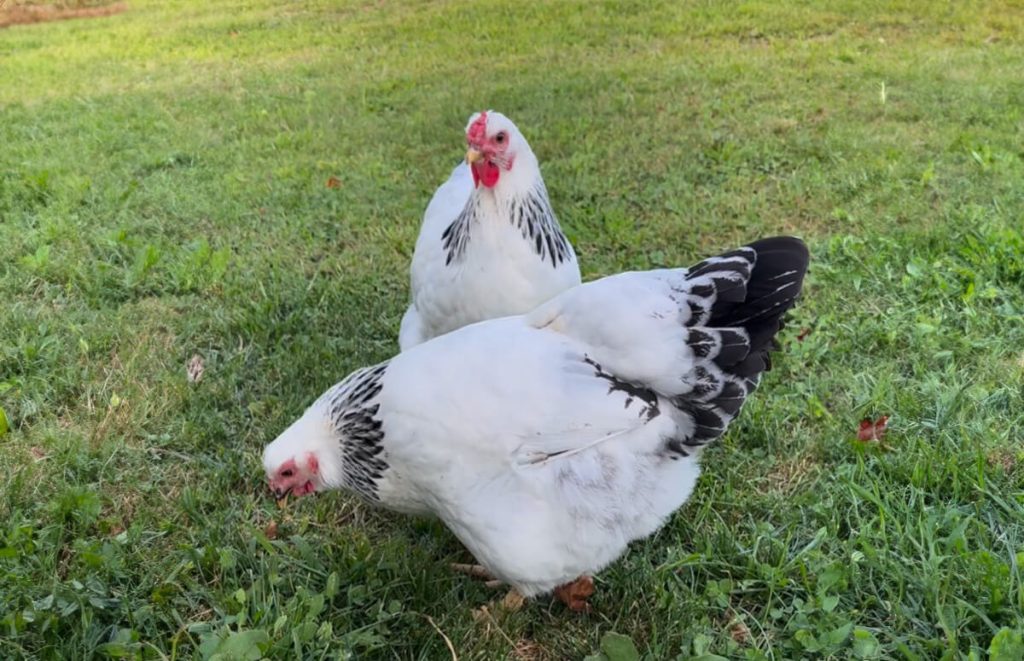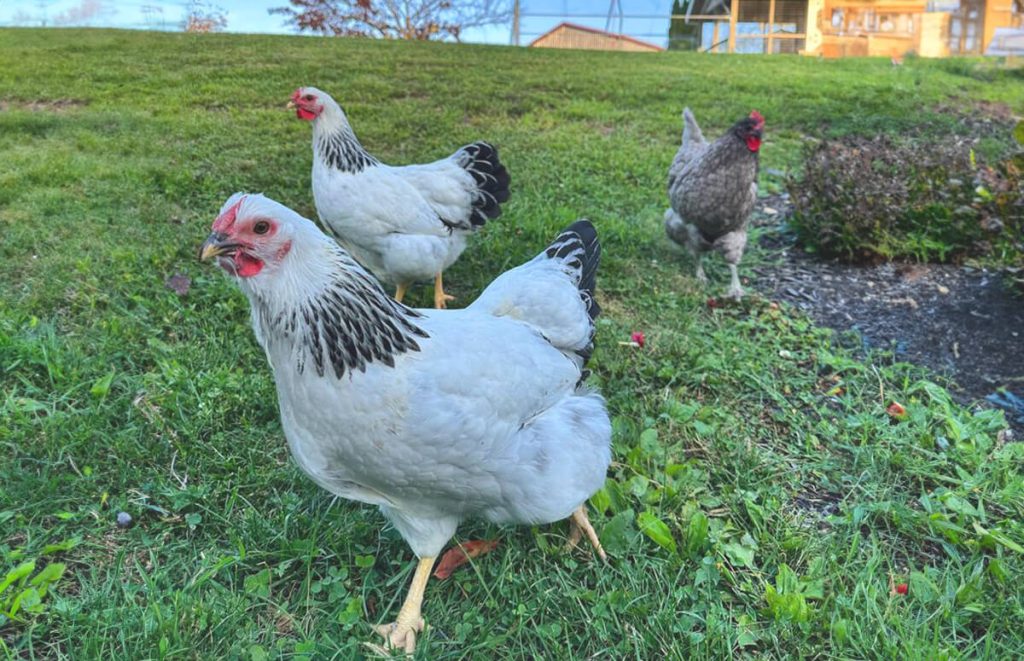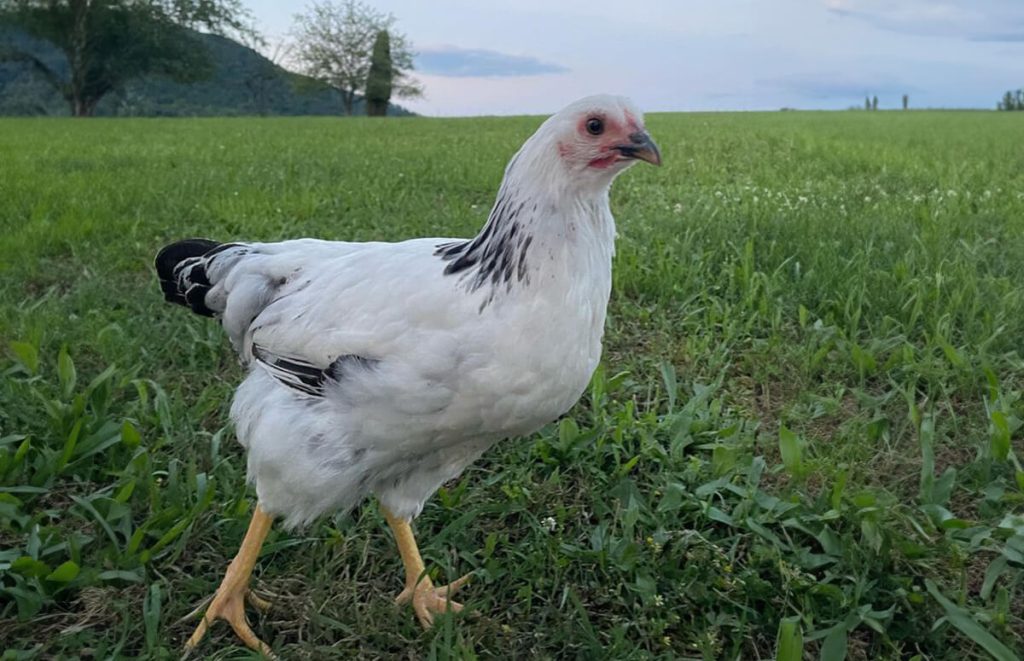Columbian Wyandotte: Breed Profile

Characteristics | Eggs | Pros & Cons | Rooster vs Hen | Climate | Columbian Color Pattern | History | Genetics | Breeding | Personality
A Columbian Wyandotte is a specific color pattern of the Wyandotte chicken. Columbian Wyandottes are known for their beautiful looks, typically featuring white feathers with black markings and tail feathers. Like other Wyandotte varieties, Columbian Wyandottes are known for their friendly and docile temperament.
| Eggs | 200 eggs/year |
| Egg Color | Brown |
| Egg Size | Large |
| Weight | 6.5 – 8 lbs |
| Hardiness | Cold |
| Temperament | Friendly but assertive |
| Beginner-friendly | Yes |
| Color | Columbian |
Characteristics
Columbian Wyandottes have a compact, well-balanced body. They are medium-sized chickens with a broad, deep, and round shape. Their body is carried in a horizontal position on bright yellow shanks.
They have a rose comb, which is relatively small and flat with multiple points, a distinctive characteristic of the Wyandotte breed. The comb follows the head and ends at the back of the head.
These Wyandottes have black & white Columbian coloring, which means they have a black tail and a black cape of feathers on the neck.

Columbian Wyandottes fall within the standard size range for Wyandotte chickens. Males typically weigh around 8 pounds (3.6 kg), while females usually weigh around 6.5 pounds (2.9 kg).
Eggs
Columbian Wyandotte hens lay brown medium- to large-sized eggs. The exact shade of brown varies from light brown to brown, depending on the individual hen.
They are good egg layers that bring around 200 eggs per year to the table. That’s less than real egg machines like the White Leghorn or the ISA Brown, but it’s still a more than decent amount.
In the winter, they usually slow down or stop laying, but if you add extra light, these cold-hardy birds tend to keep laying eggs. The only time Columbian Wyandottes stop laying eggs is during molting.
Wyandotte hens tend to go broody, which can also cause them to stop egg production.
Pros and Cons
Many people love the Columbian Wyandotte, but like any breed, it has its perks and quirks. Let’s discuss the scenarios it’s best suited for or when another breed could be a better fit.

On the positive side, these chickens do great in cold climates. Their small rose combs and fluffy bodies make them remarkably resilient to chilly temperatures. Also, their unique white and black laced plumage adds a fantastic touch to your flock. This dual-purpose breed, known for egg production and meat quality, makes them a popular choice for many homesteaders. Wyandottes are also excellent foragers, reducing the need for additional feeding.
| Pros – Reasons to choose for Wyandottes | Cons – Reasons to go for another breed |
|---|---|
| Cold-hardy Excellent foragers Dual purpose breed Beautiful color Don’t need much extra care Friendly towards people | Need more space Dominant towards smaller breeds Don’t do well in warm climates Some breeds lay more eggs They are no lap chickens Tend to go broody |
However, this also means they need more space than most other breeds. Next to that, despite their cold-hardy nature, they do not fare well in warmer climates. Additionally, Columbian Wyandottes are a dominant breed, which can result in conflicts if you keep a mixed flock. It’s best not to keep them together with submissive breeds like Silkies or Faverolles.
Columbian Wyandotte Rooster vs Hen
Columbian Wyandotte chicks are not sex-linked, so their gender cannot be determined immediately after hatching. It takes a couple of months to identify the gender, but differences in physical appearance can hint at whether you have a rooster or a hen.
| Feature | Columbian Rooster | Columbian Hen |
|---|---|---|
| Weight | 8 lbs | 6.5 lbs |
| Back | Pointed saddle feathers | Rounded feathers |
| Tail Feathers | Long sickles, pointed with green sheen | Shorter and upright, rounded on the edges |
| Comb, Wattles | Big, red | Small, pink |
| Body | Large and broad with long legs | Smaller, shorter legs |
Roosters are larger and broader than hens. They have striking white and black plumage with a prominent large rose comb. Their hackle feathers, neck, saddle, and tail feathers are black, contrasting with the white plumage. Additionally, roosters have longer and more prominent tail feathers, especially the sickle feathers.
Columbian Wyandotte hens are smaller and more modest in appearance. They also have a rose comb but it’s smaller and more pink They lack the prominent, long tail feathers seen on roosters.
Climate
Wyandottes are very cold-hardy, having been bred to survive cold American winters. Their small rose combs and plump bodies enable them to endure freezing conditions and prevent frostbite.
Nonetheless, being black and white doesn’t make them penguins, either. Their combs and wattles are still susceptible to frostbite in extremely cold weather. Always keep a close eye on your flock during extreme weather.
On the flip side, Columbian Wyandottes do not like warm temperatures. They are not the best breed to keep when you are living in a warm or tropical climate. They can quickly overheat and suffer from heat stress.
Mediterranean breeds, such as the Ancona chicken or the Andalusian, are better to keep in warm climates.

Columbian Color Variety
The world of Wyandotte chicken colors can be a complex maze. The American Poultry Association recognizes ten official color varieties in Large Fowl and Bantam, including the Columbian and Buff Columbian Wyandotte. However, the Europeans list thirty Wyandotte color varieties.
The Wyandotte chickens typically come in three classes:
- Laced Wyandottes: silver laced, gold laced, blue laced, …
- Marked Wyandottes: Columbia, Silver Pencilled, …
- Single-colored Wyandottes: white, blue, black, buff, …
The standard black-white Columbian plumage starkly contrasts black and white, with green-shining black neck hackles surrounded by a white edge, black inner webs on primary wing feathers, and black tail flight feathers.
The black-marked Columbian color variant also exists in a buff version: the Buff Columbian Wyandotte. In this variety, the main color is buff instead of white.
There are also the Blue lines in the Columbian Wyandotte series. In the Blue Columbian Wyandotte, the black neck and tail markings are replaced by lighter, blueish-grey on a white ground color. The markings in the Blue Buff Columbian Wyandotte are also blue, but on a gold-brown background that’s slightly paler than the usual buff.
History of the Columbian Wyandotte
The Wyandotte chicken was created in the United States during the 1870s by four breeders: H. M. Doubleday, John Ray, L. Whittaker, and Fred Houdlette. The Silver Laced Wyandotte was the first official color variation, gaining recognition in the American Standard of Perfection in 1883.
The Columbian Wyandotte is a variety developed as a result of selective breeding. Its creation involves combining specific breeding techniques and focusing on achieving a particular color pattern.
The Columbian variety was created by B.M. Briggs in 1893. Its name honors the Columbian Exposition and World’s Fair, which took place in Chicago, Illinois, that same year. Mr. Briggs began his work with White Wyandottes and the Barred Rock, focusing on breeding for the specific Columbian pattern.
The creator made it very clear that no Light Brahma blood was used in developing this strain of Columbian Wyandotte, which was often the case in developing other Wyandotte varieties.
The Columbian Wyandotte was officially recognized and admitted to the American Standard of Perfection in 1905.
Genetics
The looks of the Columbian Wyandotte are mainly the result of two genetic effects:
- the silvery-white ground color
- the black Columbian markings
White ground color
The standard Columbian Wyandotte is white because its DNA contains the Silver gene (S). This sex-linked gene is located on the Z chromosome. Note that there is also the Buff Columbian Wyandotte, which doesn’t have the Silver gene and has a light brown coloring.
Columbian pattern
The Columbian pattern is caused by the Columbian (Co) gene. It restricts the black pigments on the backs, wings, saddle, and parts of the tail.
Interestingly, the Silver Laced Wyandotte also carries the Columbian gene in its DNA but has an entirely different color pattern. The interplay of several genes causes the scalloped pattern of the Silver Laced: Pg (Pattern), Ml (Melanotic), and Co (Columbian). Pg creates lines, Ml shifts them to the edge and Co removes inner stripes.
The difference is that Columbian Wyandottes don’t have the melanotic gene (Ml). The Silver Laced Wyandotte has two copies of the Ml-gene (Ml Ml), resulting in black striping at the rim of the feathers. The Columbian Wyandottes don’t (ml+ ml+), which results in the Columbian pattern.
Breeding
The main challenge in breeding Columbian Wyandottes is to get the striking contrast between black and white. The neck hackles should have a green-shining black pattern surrounded by a white edge. The primary wing feathers should also have a completely black inner web. In addition, the tail flight feathers should be black.
But nature has its limitations. If you breed with white animals to get a beautiful base color, the pattern fades. On the other hand, if you pick birds with a lot of pigment, they will often show a less bright white color.
Common issues that breeders encounter are:
- Insufficient patterning in the neck hackles
- White in the sickles
- Black popping up on the wings, flanks, or chest
- Intense yellow hue in the ornamental feathers
Blue Markings
It becomes extra challenging for breeders that try to make Blue Columbian Wyandottes or Blue Buff Columbian Wyandottes. In these non-official color varieties of the Wyandotte, the black neck and tail markings are replaced by blue (greyish) ones.
Personality
Columbian Wyandottes are known for their pleasant personalities. They are friendly towards humans and children. Their adaptability, social nature, and calm disposition make them an excellent choice for newbies and experienced chicken keepers.
However, Wyandottes can display dominant behavior towards other chicken breeds. While generally calm and friendly, they may assert themselves when interacting with submissive or bantam breeds. This behavior often helps to maintain the pecking order within the flock but should be monitored to ensure that all chickens coexist harmoniously.
Other Reads
Here are some of the articles we mentioned:
- Wyandotte Chickens: an overview of the Wyandotte chicken breed and the color varieties
- Silver Laced Wyandotte: a breed profile of the Silver Wyandotte variety
- Golden Laced Wyandotte: a breed profile of the Golden Laced Wyandotte variety
- Splash Laced Red Wyandotte: a breed profile of the Splash Laced Red Wyandotte
- White Wyandotte: a breed profile of the White Wyandotte
- Sebright Chickens: a chicken breed that has varieties with a similar lacing pattern
- Brahma Chickens: large chicken breed initially used to create the Wyandotte
- Hamburg Chickens: chicken breed used to create the Wyandotte, with similar black and white patterns
- Chicken Feather Guide: to understand the difference between all types of feathers
- Chicken Breeding & Genetics: an overview for chicken breeding and genetics for beginners
If you are considering to get Silver Laced Wyandottes, here are some other resources:
- Chicken Coop Size Calculator: to calculate the size of your coop
- Chicken Raising Guide: general chicken raising guide
Credits for the featured image and special thanks go to Oh Happy Hen.






















